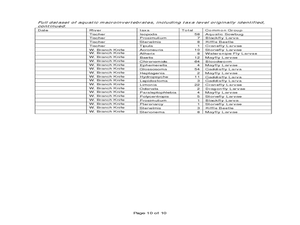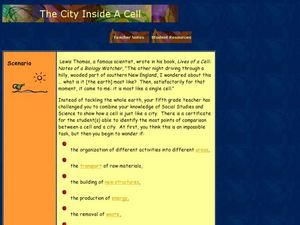Curated OER
Barrier Islands
Third graders explore how barrier islands work. In this erosion lesson, 3rd graders create barrier islands in stream tables and simulate wave action to see how it affects their island.
Curated OER
Mix It Up : Colors
Fifth graders make predictions of the resulting colors when colors are mixed. In this colors lesson, 5th graders discuss vocabulary related to mixing colors. Students are asked to paint a picture of five colors from two colors of...
Curated OER
It Matters
Students use descriptive vocabulary to discuss the attributes of matter. Then, they sort objects or pictures by the type of matter they are comprised of. Finally, students match objects of matter with similar attributes and create a...
Curated OER
The New Organon
In this online interactive history worksheet, students respond to 10 short answer and essay questions about Francis Bacon's The New Organon. Students may check some of their answers on the interactive worksheet.
Curated OER
Aquatic Invertebrates
Learners examine the impact that human development has on streams. In this stream sampling lesson students compare macroinvertebrate data and graph it.
Curated OER
Happy Habitats
Students explore different habitats. In this habitat lesson plan, students investigate four different habitats through participating in a WebQuest. Students create an animal web using Kidspiration or a video documentary upon completing...
Curated OER
Something Fishy Going On
Learners create a video animation of how Swimmy gathered his fish friends together to form a great big fish that would frighten the predator tuna away. In art class each child create a small red fish which gets displayed in the ocean...
Curated OER
Woodland Animals and Their Habitat
Learners explore the natural environment through a video and nature sounds tape. They keep journal's of the unit's activities and vocabulary terms. They play a web of interdependence game and compose a list of forest animals and write...
Curated OER
Our Zoo Friends
First graders plan and create a model zoo depicting the natural habitats of animals. Their models include animals and a display of written factual information about the animals. Students present their project by conductig a tour of...
Curated OER
Plant Needs
Students explore the needs of plants. In this plants biology lesson, students work in groups to perform an experiment with tomato plants. Each group records observations in a journal, takes pictures, and interprets the results of...
Curated OER
Insulators and Conductors
Fourth graders experiment to discover which items are conductors and which items are insulators. In this insulators and conductors instructional activity, 4th graders experiment and create a T-Chart. Students are assessed on the...
Curated OER
Fin, Feathers, or Fur?
Students learn how to classify animals. In this animal characteristics instructional activity, students read Granddad's Animal Alphabet Book, brainstorm a list of different kinds of animals, and determine their characteristics; fur,...
Curated OER
Falling Into Leaves
Students investigate why leaves change color. In this chlorophyll lesson, students examine how chlorophyll effects the color changes in leaves. Students take pictures of changing leaves, and create a class quilt showing the changes of...
Curated OER
A House for Me- Ocean Environments
Learners explore ocean environments. For this ocean environment lesson, students identify the things ocean animals need for survival. Learners use KWL charts and search the Internet collecting information about ocean habitats. Students...
Curated OER
Tops and Bottoms
First graders classify vegetables by which parts are edible. In this plant biology lesson, 1st graders are read Tops and Bottoms by Janet Stevens, participate in a discussion of which plant parts are edible in the story, then sort real...
Curated OER
Water Treatment Plant
Second graders create their own water treatment system. In this water treatment lesson, 2nd graders create the water treatment system and record how it works. Students list materials they used and write about what they saw. Students then...
Curated OER
Endangered!
Students research endangered species. In this ecology and literacy research lesson, students work with a partner to research an endangered species of their choice. Students choose from a variety of presentation methods and materials,...
Curated OER
Sensitive Taste Test
Fifth graders investigate concentrated and diluted solutions by conducting a taste test. In this dilution lesson plan, 5th graders examine the concentration of different juices samples by tasting them and recording their observations....
Curated OER
Building a Model Springbox
Learners examine ways to protect fresh drinking water. In this clean drinking water lesson, students listen to the story of Lauren Fry about building a springbox to collect groundwater. Learners build a springbox.
Curated OER
Gettysburg Rocks Recycle to Win
Eighth graders use a geologic cross section to study the rock cycle of the Gettysburg battlefield. In this rock cycle lesson, 8th graders connect the rock cycle and continental rifting.
Curated OER
Creating the Ideal Cargo Boat
Students build boats out of clay to test the buoyancy of the boat in water. Students break into pairs and construct their boat to specific guide lines, then experiment with their boat in the water.
Curated OER
For the Birds
Second graders explore biology by creating birdhouses. For this bird identification lesson, 2nd graders discuss the different types of birds that live in their environment and what characteristics each type of bird has. Students create a...
Curated OER
The City Inside a Cell
Students compare cell structure to the structure of a city. In this cell structure lesson, students investigate differences and similarities between cell structure and city structure. Students create a 3-dimensional, edible model of a cell.
Curated OER
What are Stars?
Young scholars research the solar system and it's characteristics. For this solar system lesson, students are broken into 4 groups, each assigned a specific part of the solar system. Young scholars use the Internet to research their...

























